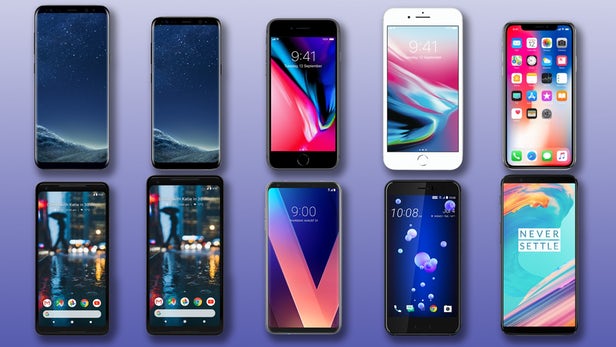In this comprehensive comparison, we look at:
- Samsung Galaxy S8
- Samsung Galaxy S8+
- iPhone 8
- iPhone 8 Plus
- iPhone X
- Google Pixel 2
- Google Pixel 2 XL
- LG V30
- HTC U11
- OnePlus 5T
Size
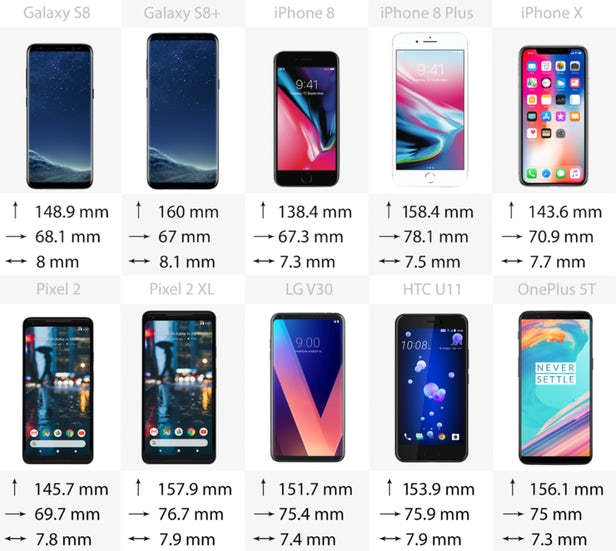
Physically, this year’s flagships run the gamut from petit to pocket-hogging, with the plus-sized Galaxy S8+, iPhone 8 Plus, Pixel 2 XL and OnePlus 5T all firmly in phablet territory. The base model iPhone 8 is the smallest by a wide margin, but with a mix of shapes out there, the title of largest is tied between the 160-mm-tall Galaxy S8+ and the 78-mm-wide iPhone 8 Plus.
Weight
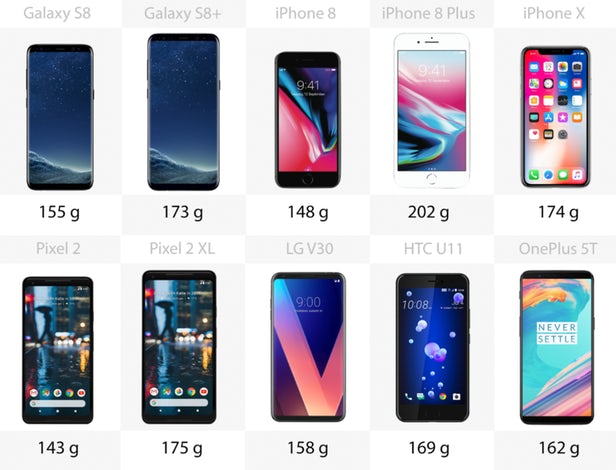
Tipping the scales at over 200 g, the iPhone 8 Plus is the clear heavyweight champion of the year. For reference, a nickel weighs 5 g, so the difference between that and the lightest phone on the list, the Google Pixel 2, is about the equivalent of carrying around 12 of the coins.
Colors
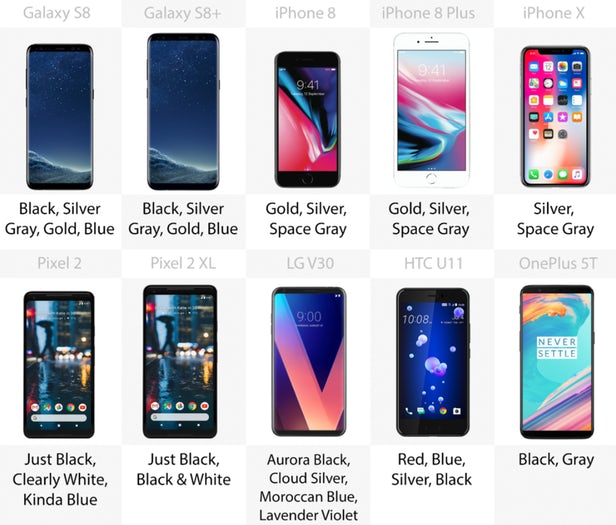
Fancy names aside, most of these phones come in muted tones of black, silver and gray. If you want a splash of color, some makers offer gold, blue and red choices too – although you can always just wrap it in a case if you want a different look anyway.
Build
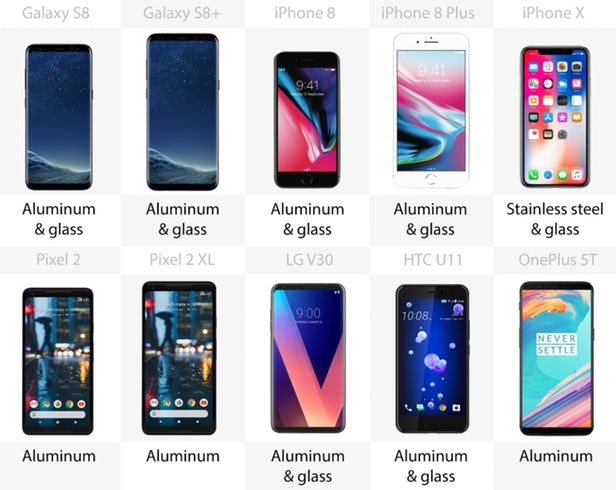
Glass backs are back in vogue, with Apple, LG and HTC all ditching the aluminum unibody of last gen. For the iPhones and the V30, the choice was apparently made to allow for wireless charging, while HTC has basically said it just wanted to make the U11 look prettier. Samsung’s phones have been glass front-and-back for years now, while Google and OnePlus have stuck with a sturdier aluminum backing.
Water resistance
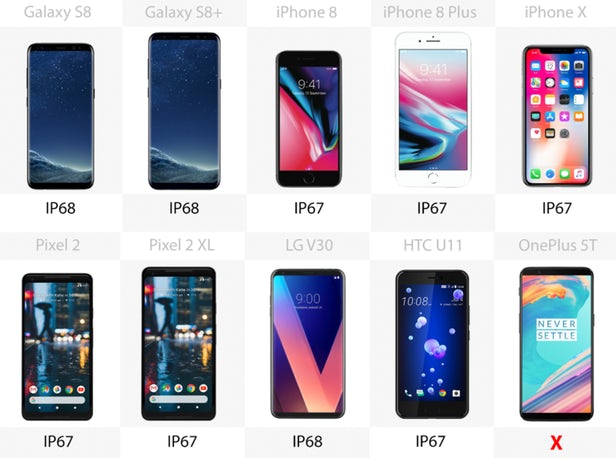
With the sole exception of the OnePlus 5T, all the major phones can repel water and dust effectively. An IP67 rating means the device is dust-tight and can be immersed in water up to 1 m deep for 30 minutes, while IP68 extends that to a depth of 1.5 m. In practical terms, we wouldn’t recommend swimming with any of these phones in your pocket, but they should bounce back from the odd splash of water or a quick accidental dunk.
Display size
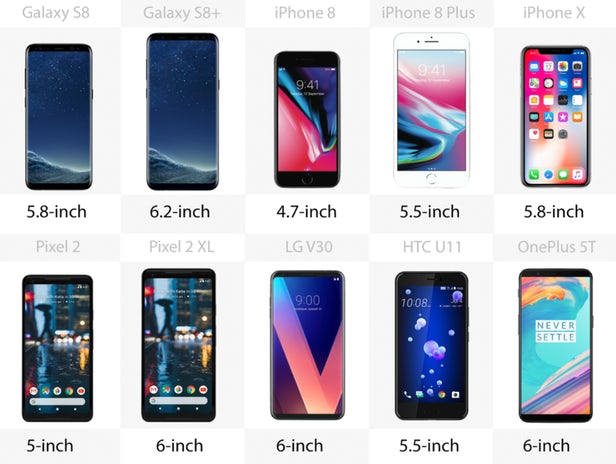
Despite their disparate physical sizes, the phones’ displays all hover around 5.5 to 6 inches. The Galaxy S8+ sports the biggest screen at 6.2 in, while the tiny iPhone 8 is the only device to come in under 5 in. But hey, it’s what you do with it that really matters, right?
Screen-to-body ratio
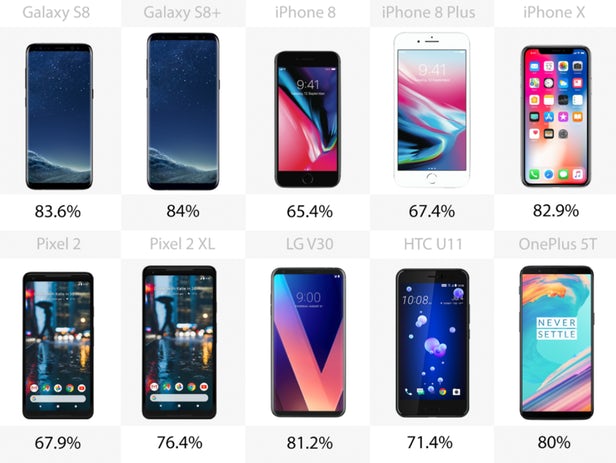
2017 was the year that smartphone makers decided bezels weren’t cool anymore, so most of the flagships squeeze more screen onto the front than ever. Samsung’s latest Galaxy phones make the best use of space, with screens that wrap around the sides. Not far behind is the iPhone X, with only a black bar along the top that houses the TrueDepth camera.
The V30 and OnePlus 5T do a good job of stretching out their screens too, but the bulky frames around both iPhone 8 models, the Pixel 2 phones and the U11 are starting to look a little dated.
Display Resolution
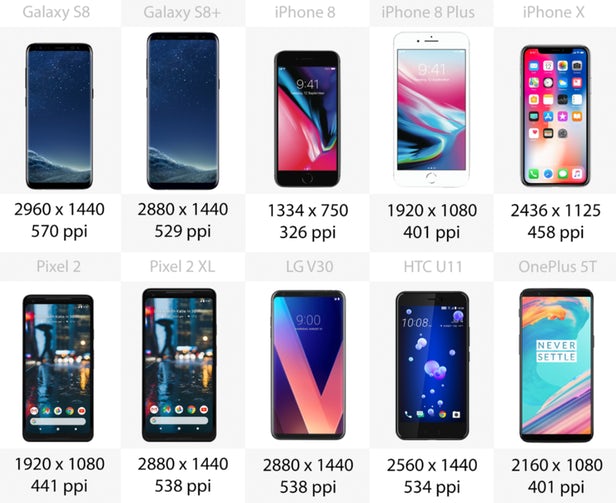
For high-end phones, a Full HD resolution of 1920 x 1080 is usually the minimum, and most go beyond that. The base model iPhone 8 is the only phone on this list to fall short of that bar, while the 8 Plus and the Pixel 2 just meet it. Still, you might not notice as much since Apple usually employs other tricks to keep its displays looking sharp.
They all look pretty schmick, but the highest-resolution screens can be found on Samsung’s phones, the Pixel 2 XL and the multimedia-focused V30.
Display type
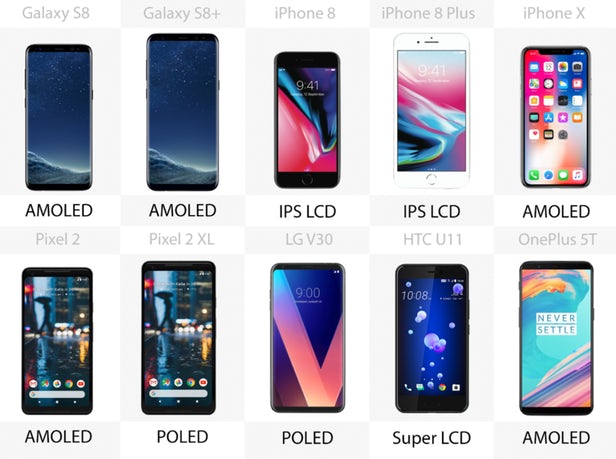
The iPhone X marks Apple’s first foray into OLED technology, although IPS LCD still has its upsides. Generally speaking, AMOLED (and the POLED variant) provides brighter colors, deeper blacks and better contrast, while IPS LCD is said to be sharper and offer more natural colors. Neither is clearly better than the other, so it comes down to individual implementation and tastes.
Biometrics
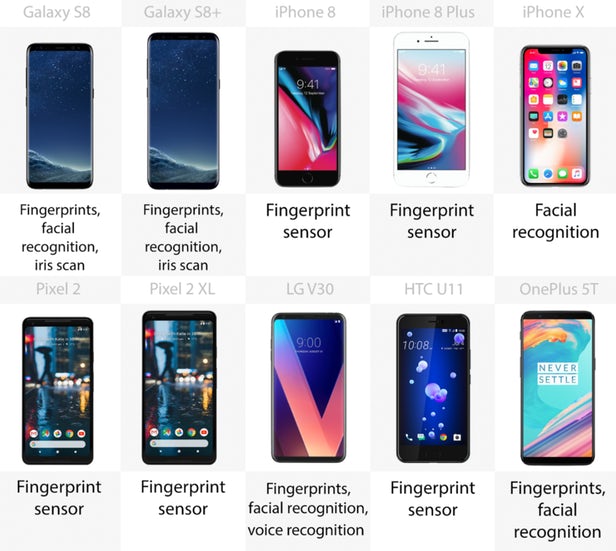
Fingerprint scanners are the norm nowadays, with only the iPhone X ditching it in favor of its new “FaceID” system. Samsung, LG and OnePlus manage to offer both, although Apple’s facial recognition tech appears to be more advanced and less easily-fooled. The Galaxy phones can also be “unlocked with a look” thanks to their iris scanners, while the V30 can recognize its owner’s voice.
Processor
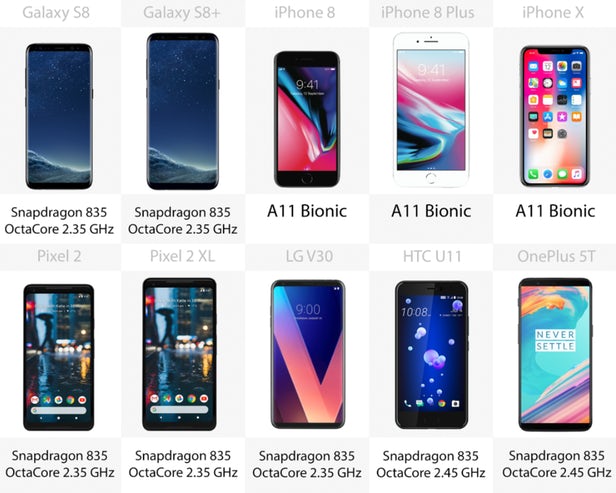
This year’s iPhones are powered by Apple’s latest chip, the A11 Bionic. The rest of the list are all running on Qualcomm’s Snapdragon 835 processor.
RAM
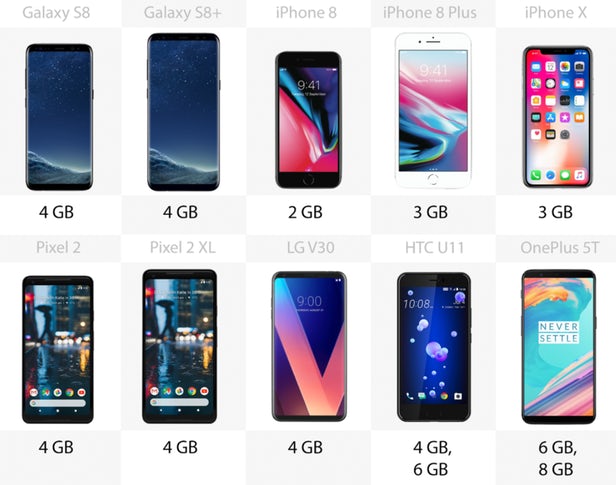
In terms of RAM, 4 GB is all but standard. HTC offers a 6 GB version of the U11, while the OnePlus 5T makes that the baseline and adds a beefy 8 GB model. The iPhones are relatively modest in the RAM department, but keeping tight control over the operating system means Apple can wring better performance out of lower specs.
Onboard storage
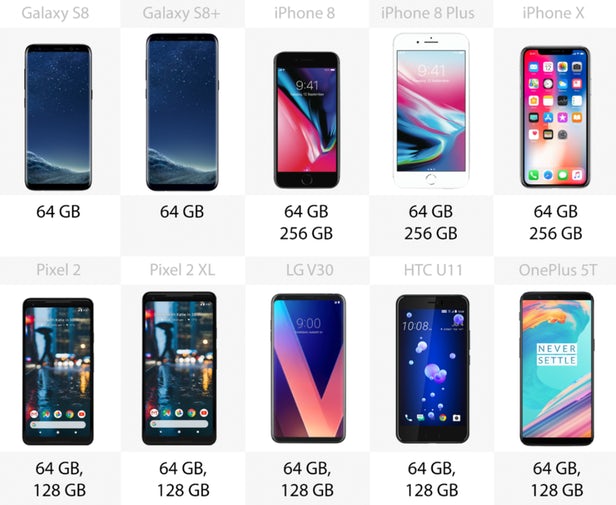
ou can expect a decent 64 GB of storage space no matter which phone you pick up, and with most you can double that for a price. LG calls the roomier model of its phone the V30+, while HTC and OnePlus bolster their 128 GB models with extra RAM too (6 GB and 8 GB, respectively).
In the case of the iPhones, Apple gives the option for an almost unparalleled 256 GB.
MicroSD
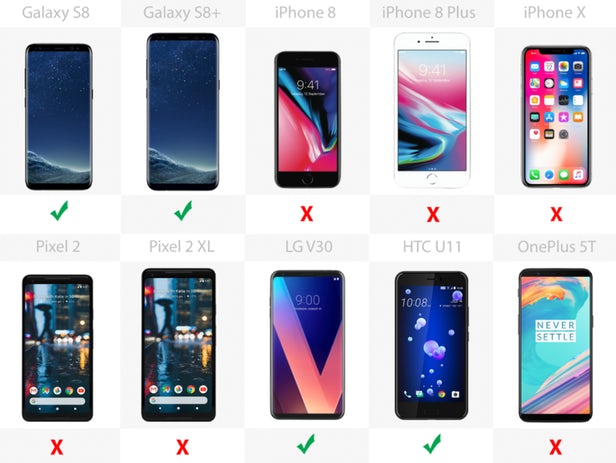
The Galaxy S8 and S8+ only have 64 GB storage built in, but to compensate that can be expanded with the use of a MicroSD card. The LG V30 and HTC U11 also offer that expansion option, while you get what you’re given with the rest of the phones.
Battery
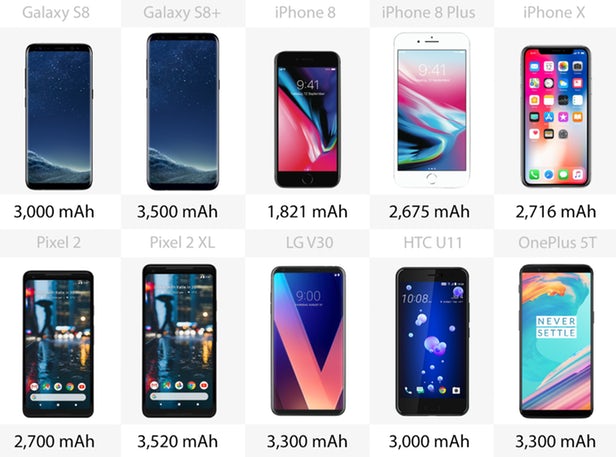
In terms of battery capacity, the phones on this list all hover around the 3,000 mAh mark. The Galaxy S8+ and Pixel 2 XL pack the juiciest batteries, while the iPhone 8 again falls the shortest. Still, in practical terms, you’ll likely get a whole day’s use on a full charge from all of these devices – at least at first.
Ports
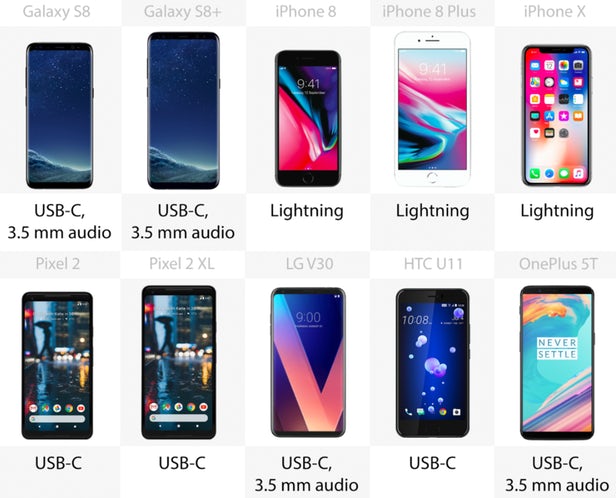
Last year Apple infamously nixed the industry-standard 3.5 mm headphone jack on the iPhone 7, and with other big players following suit in 2017 it’s beginning to look like it might have been a lethal blow. You’ll need to use Bluetooth headphones or an adapter for the iPhone 8, 8 Plus and X, as well as the HTC U11 and Google’s Pixel 2 and 2 XL. All of the phones charge via USB Type-C, except for the iPhones that use Apple’s proprietary Lightning port.
Fast charging
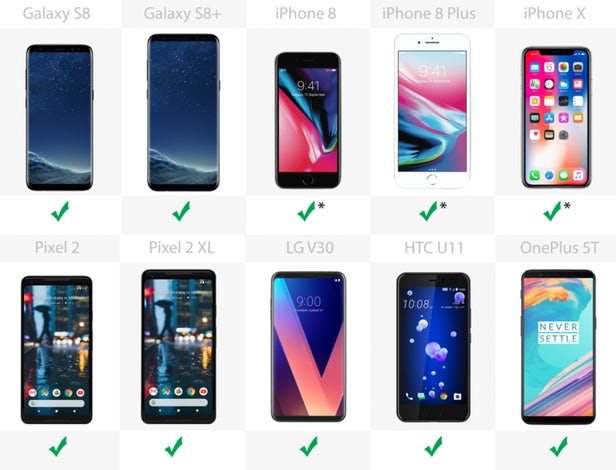
The ability to quickly top up your phone’s battery is common to all the phones on this list, but while it’s standard out-of-the-box on the Android devices, you’ll need to buy a separate accessory to do so on the iPhones.
Wireless charging
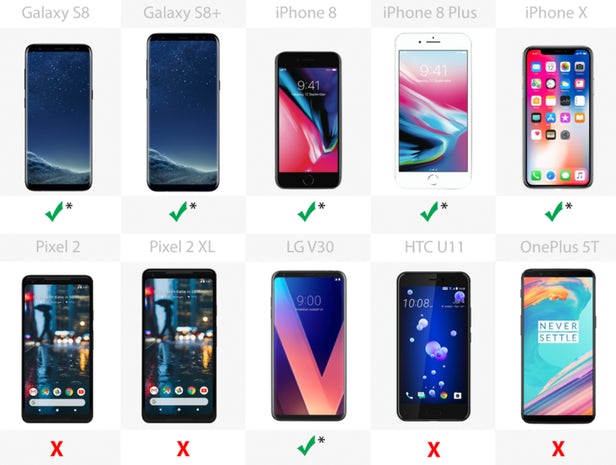
Wireless charging is becoming more widespread, but you’ll have to buy a charging pad separately. The Pixels, U11 and OnePlus 5T lack the ability, but to be honest, it’s no big loss. Until a phone can be charged from a distance while you’re using it, the feature is far from necessary.
Cameras
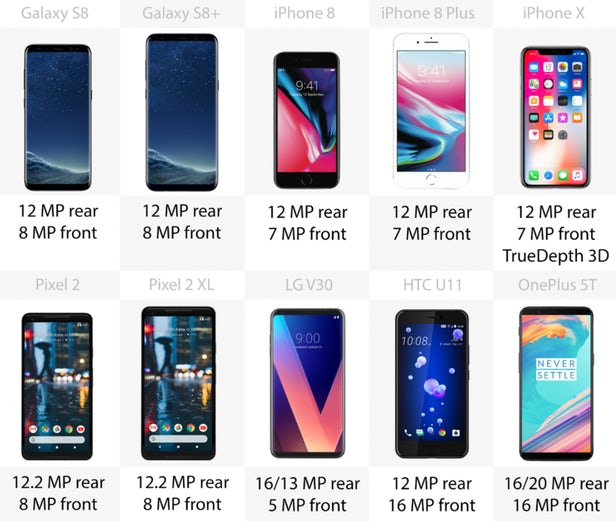
There’s more to a camera than its megapixel count of course, but it’s a good place to start. The two Galaxies, iPhone 8s and Pixel 2s are all very similar in that regard, while the HTC U11 packs a far higher resolution into its selfie cam.
The iPhone X’s front-facing camera is equipped with a depth-sensor, allowing it to scan a user’s face in three dimensions for better security (and emoji-puppeteering).
The LG V30 and OnePlus 5T are both built with dual cameras, for wide-angle shots and better panoramas.
Operating system
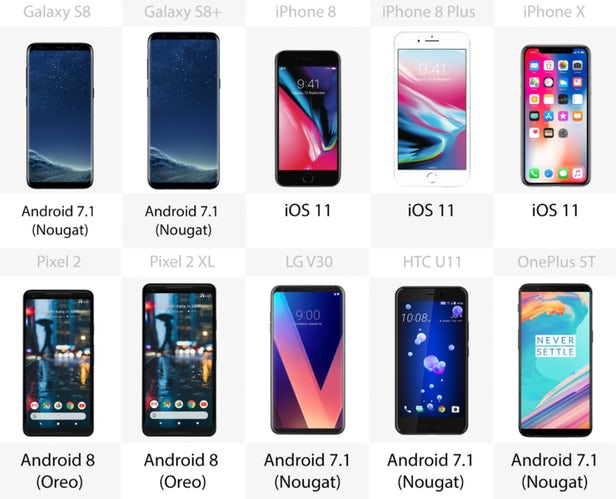
The three iPhones are all running the latest version of Apple’s iOS, while Google’s offerings come preloaded with the most up-to-date Android OS. The other phones are still running Android Nougat, and likely will be for a while yet.
Assistant
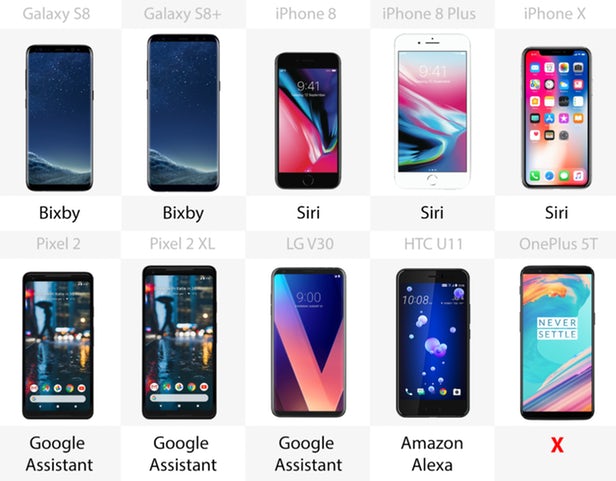
Voice-controlled assistants are part and parcel, and although each company is developing their own they all do much the same stuff. Stalwart Siri is still sticking around on the iPhones, while Samsung unveiled Bixby with the launch of the galaxy S8 line. Google packs its own Assistant into the Pixels and lends it to LG as well, and the HTC is the first phone to leverage Amazon’s Alexa. The OnePlus 5T is the only phone to go without, although it can still perform some really basic functions via voice control.
Release date
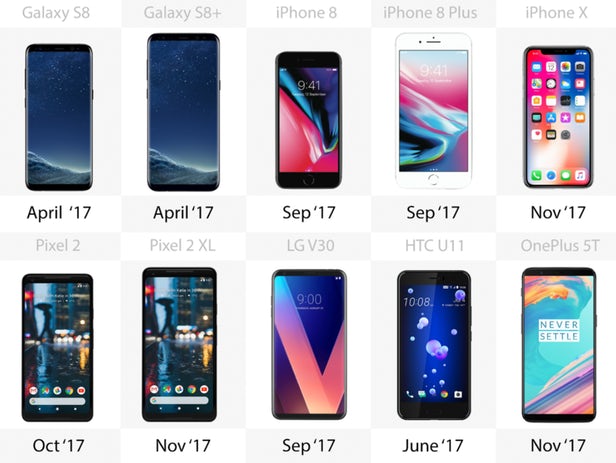
Samsung’s 2017 phones were the first to launch back in April, shortly followed by the HTC U11 in June. After a bit of a dry spell, New Phone Season began again in September, October and November.
Price (US$)
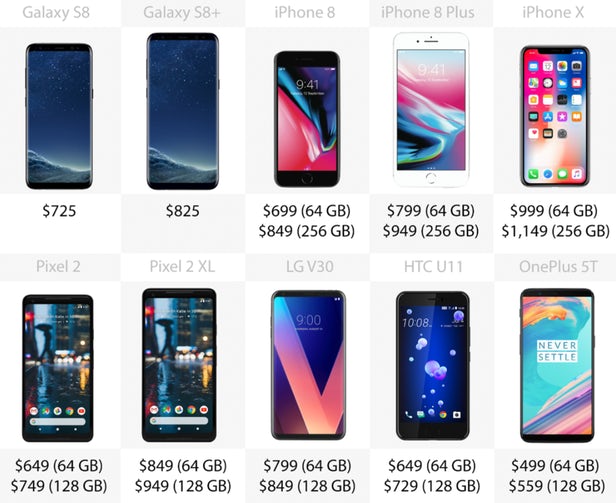
Phones like the HTC U11 and OnePlus 5T are classed as mid-range, but as we’ve seen their specs often match phones with price tags hundreds of dollars higher. At $499, the OnePlus 5T is a steal. Up the other end of the scale, the iPhone X has soared past a grand, but the wow-factor means it’s had no trouble selling units anyway.













